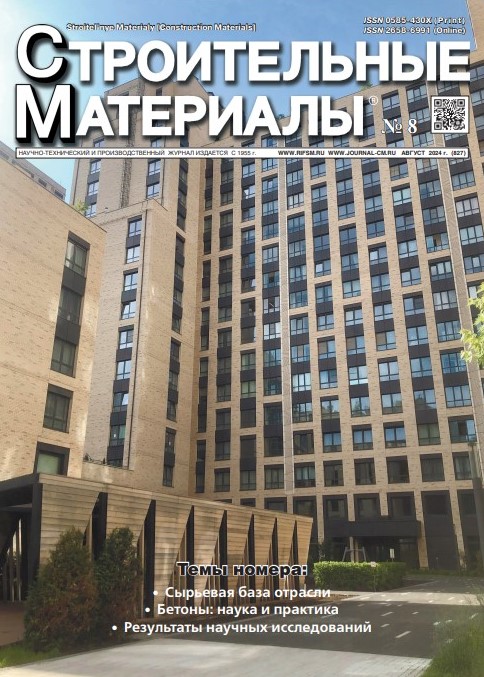Self-adhesive elastic radiation protective coatings
- Autores: Rimshin V.I.1,2, Cherkasov V.D.3, Cherkasov D.V.3, Savin V.K.1
-
Afiliações:
- Research Institute of Building Physics of RAACS
- National Research Moscow State University of Civil Engineering
- National Research Mordovia State University named after N.P. Ogarev
- Edição: Nº 8 (2024)
- Páginas: 56-62
- Seção: Статьи
- URL: https://rjdentistry.com/0585-430X/article/view/635778
- DOI: https://doi.org/10.31659/0585-430X-2024-827-8-56-62
- ID: 635778
Citar
Texto integral
Resumo
Elastic self-adhesive radiation protective coatings with high adhesive strength to various substrates have been developed and can be applied to surfaces of any shape. In terms of radiation protection properties, they surpass foreign analogues by 15–35% barite-containing at an energy of 0.059 MeV, by 8%, 30% and even 200% tungsten-containing at an energy of 0.661 MeV. In terms of cost, tungsten-containing materials are 2–3 times cheaper than foreign analogues, and barite materials are 67–109 times cheaper than foreign analogues, and 2–3.5 times cheaper than domestic ones. With an absorbed radiation dose of 2.62.107 Gy (threshold value of 105 Gy), they retain radiation-protective properties and have minor damage.
Palavras-chave
Texto integral
Sobre autores
V. Rimshin
Research Institute of Building Physics of RAACS; National Research Moscow State University of Civil Engineering
Autor responsável pela correspondência
Email: v.rimshin@niisf.ru
Doctor of Sciences (Engineering), Professor
Rússia, 21 Lokomotivny proezd, Moscow, 127238; 26 Yaroslavskoye Shosse, Moscow, 129337V. Cherkasov
National Research Mordovia State University named after N.P. Ogarev
Email: vd-cherkasov@yandex.ru
Doctor of Sciences (Engineering)
Rússia, 68 Bolshevistskaya Street, Saransk, 430005D. Cherkasov
National Research Mordovia State University named after N.P. Ogarev
Email: dv-cherkasov@yandex.ru
Candidate of Sciences (Engineering)
Rússia, 68 Bolshevistskaya Street, Saransk, 430005V. Savin
Research Institute of Building Physics of RAACS
Email: v.rimshin@niisf.ru
Doctor of Sciences, Corresponding Member of RAACS
Rússia, 21 Lokomotivny proezd, Moscow, 127238Bibliografia
- Cherkasov V.D., Pilshchikov V.O., Avdonin V.V., Yurkin Yu.V. Self-adhesive radiation protective coatings. Regional’naya arkhitektura i stroitel’stvo. 2019. No. 4 (41), pp. 20–26. (In Russian).
- Mikaeva S.A., Mikaeva A.S., Boychuk M.I. Protective coating for radiation sources Avtomatizatsiya. Sovremennyye tekhnologii. 2016. No. 7, pp. 34–36. (In Russian).
- Cherkasov V.D., Avdonin V.V., Cherkasov D.V., Shcherbak Yu.P., Yurkin Yu.V. Self-adhesive radio-absorbing coatings. Regional’naya arkhitektura i stroitel’stvo. 2022. No. 4 (53), pp. 41–50. (In Russian).
- Pavlenko V.I., Yastrebinsky R.N. Polimernyye radiatsionno-zashchitnyye kompozity: monografiya [Polymer radiation-protective composites: monograph]. Belgorod: BSTU named after V.G. Shukhov. 2009. 219 p.
- Pavlenko V.I., Sokolenko I.V., Noskov A.V. New type composite material for complex radiation protection. Chemistry and chemical technology. 2015. Iss. 6. Vol. 58, pp. 66–69. (In Russian).
- Pavlenko V.I., Bondarenko G.G., Cherkashina N.I. Development of neutron-shielding polymer composites based on finely ground titanium hydride. Perspektivnyye materialy. 2016. No. 7, pp. 16–21. (In Russian).
- Draganyuk O.N., Telegin S.V. Optimization of the ratio of components in the layers of the radiation-protective screen. Design and production of aircraft, space research and projects: Reshetnev readings. Krasnoyarsk. 2016, pp. 21–22. (In Russian).
- Khozin V.G. Construction sealants. Operating conditions, requirements for properties. Proceedings of the scientific and practical conference «Production and consumption of sealants and other construction compositions: status and prospects». Kazan. 1997, pp. 9–20. (In Russian).
- Ivanenko T.A., Kolbutova L.I. Self-adhesive materials and their application in plastics processing. Klei. Germetiki. Tekhnologii. 2006. No. 3, pp. 19–22. (In Russian).
- Kimel L.R., Mashkovich V.P. Zashchita ot ioniziruyushchikh izlucheniy: spravochnik [Protection from ionizing radiation: reference book. 2nd ed.] Moscow: Atomizdat. 1972. 312 p.
- Özdemir T., Güngör A., Reyhancan İ.A. Flexible neutron shielding composite material of EPDM rubber with boron trioxide: Mechanical, thermal investigations and neutron shielding tests. Radiation Physics and Chemistry. 2017. Vol. 131, pp. 7–12. https://doi.org/10.1016/j.radphyschem.2016.10.012
- Ochkina N.A. Influence of the type and concentration of filler on the radiation-protective properties of the composite. Obrazovaniye i nauka v sovremennom mire. Innovatsii. 2018. No. 5 (18), pp. 205–211. (In Russian).
- Bormotov A.N., Proshin A.P., Bazhenov Yu.M., Danilov A.M., Sokolova Yu.A. Polimernyye kompozitsionnyye materialy dlya zashchity ot radiatsii: monografiya [Polymer composite materials for radiation protection: monograph]. Moscow: Paleotype Publishing House, 2006. 272 p.
- Rimshin V.I., Kalaydo A.V., Semenova M.N., Borsch V.A. Construction technologies for ensuring radon safety of buildings. Stroitel’nye Materialy [Construction Materials]. 2023. No. 6, pp. 33–38. (In Russian). https://doi.org/10.31659/0585-430X-2023-814-6-33-38
- Rimshin V.I., Kalaydo A.V., Semenova M.N., Davyskiba O.V. Calculation of underground walling according to the criteria of a building radon safety. Zhilishchnoe Stroitel’stvo [Housing Construction]. 2023. No. 7, pp. 40–46. (In Russian). https://doi.org/10.31659/0044-4472-2023-7-40-46
- Rimshin V.I., Kalaido A.V., Semenova M.N., Nikitin A.A., Molchanova A.E. Radiation risks in the textile industry. Izvestiya of higher educational institutions. Technology of textile industry. 2023. No. 4 (406), pp. 185–191. (In Russian).
- Telichenko V., Rimshin V., Kalaido A., Marya S. prediction of the radon situation in buildings constructed under the renovation program. E3S Web Conference. 2023. Vol. 457. International Scientific and Practical Symposium «The Future of the Construction Industry: Challenges and Development Prospects» (FCI-2023). https://doi.org/10.1051/e3sconf/202345702041
Arquivos suplementares












